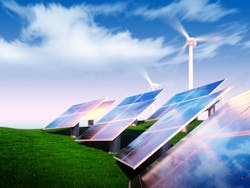Groups Urge California Governor to Support Community Microgrids: “A Just Transition to Clean Energy”
Because microgrids offer communities greater control over their energy supply, they’re viewed as a mechanism to help marginalized communities that struggle with the dual burden of poverty and dirty air.
Clean energy microgrid projects in rural Africa and India demonstrate the idea. But in the US, use of microgrids as a community-improvement tool has been slower to catch on — although budding efforts are underway in places like Baltimore, Boston, Chicago and New York.
Now California, with its outsized influence on clean energy markets, has a chance to turbo charge the concept, using local energy to not only help marginalized communities, but also tackle the state’s homegrown problem of power outages related to wildfire prevention.
A group of advocacy organizations late last week delivered a letter to Governor Gavin Newsom urging California to pursue what they called “a just transition to clean energy.”
The timing is especially important, since COVID-19 disproportionately harms Black and Brown communities, as the letter notes. A 2019 study by the University of Washington and Stanford University found that black and low-income people face the highest risks for death from fine particle matter, pollution from power plants, which are more likely to be sited in their communities. A more recent Harvard study found that exposure to even a small amount of particulate matter can lead to a large increase in the death rate from COVID-19.
Climate justice and racial justice linked
“There cannot be climate justice without racial justice,” said Ellie Cohen, CEO of The Climate Center, one of 18 groups that signed the letter. “Many communities of color are being hit much harder than others by COVID-19 and climate change. State policy needs to prioritize and fund initiatives for deploying resilient clean energy.
To be clear, the state already promotes microgrids in a range of ways, including substantial grants. An ongoing proceeding before the California Public Utilities Commission, which finished up its first phase last week, is seeking additional ways to encourage microgrid deployment.
But the groups are asking the state to look hard at microgrids in a new light, one that reflects immediate problems, including the COVID-19 economic downturn. Microgrids offer a way for communities to manage energy costs, not only to achieve savings but earn potential revenue.
The groups specifically ask Newsom to:
- Emphasize community-centric, local resilience planning
- Leverage microgrids to serve critical facilities, support clean emergency back-up power, and address community resilience needs
- Commit to California’s clean transportation transition to reduce the state’s largest source of greenhouse gases
“It is vital that the state protect the environmental, equity, and resilience gains that we have made and ensure that future economic stimulus rebuilds California in the right direction to meet our climate and clean air goals, particularly in disadvantaged and low-income communities of color, as well as tribal communities,” says the letter.
The groups offer specific pathways forward, such as the state assured financing for solar plus storage at K-12 schools in areas where wildfire related public safety power shutoffs are likely.
Community-based energy decisions
“Microgrids fortify resilience in local communities by creating critical, energy-secure facilities during public safety power shutoff events and other disasters,” says the letter.
In addition to offering reliable energy during power outages, microgrids can be built as an alternative to “climate-vulnerable transmission lines that pose a significant wildfire risk.” Fire investigators have traced wildfire ignition, in some cases, to sparks from wires designed to carry electricity long distances.
To boost local energy, the groups want to bring the community into the energy planning process.
“Local governments need to work with their residents and partner with community-based organizations to make engaged and educated clean energy decisions that create resilience solutions and meet the needs identified by the communities,” says the letter.
In addition to The Climate Center, groups that signed the letter include: the Center for Sustainable Energy, The Clean Coalition, Vote Solar, The Microgrid Resources Coalition.
Track news about community microgrids. Subscribe to the free Microgrid Knowledge newsletter.
About the Author
Elisa Wood
Editor-in-Chief
Elisa Wood is the editor and founder of EnergyChangemakers.com. She is co-founder and former editor of Microgrid Knowledge.
